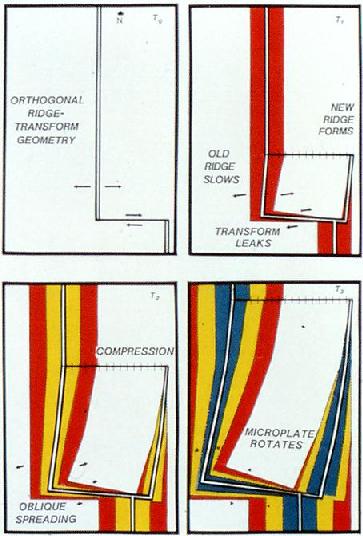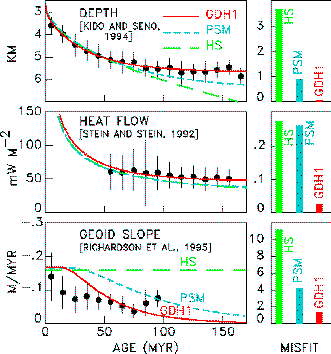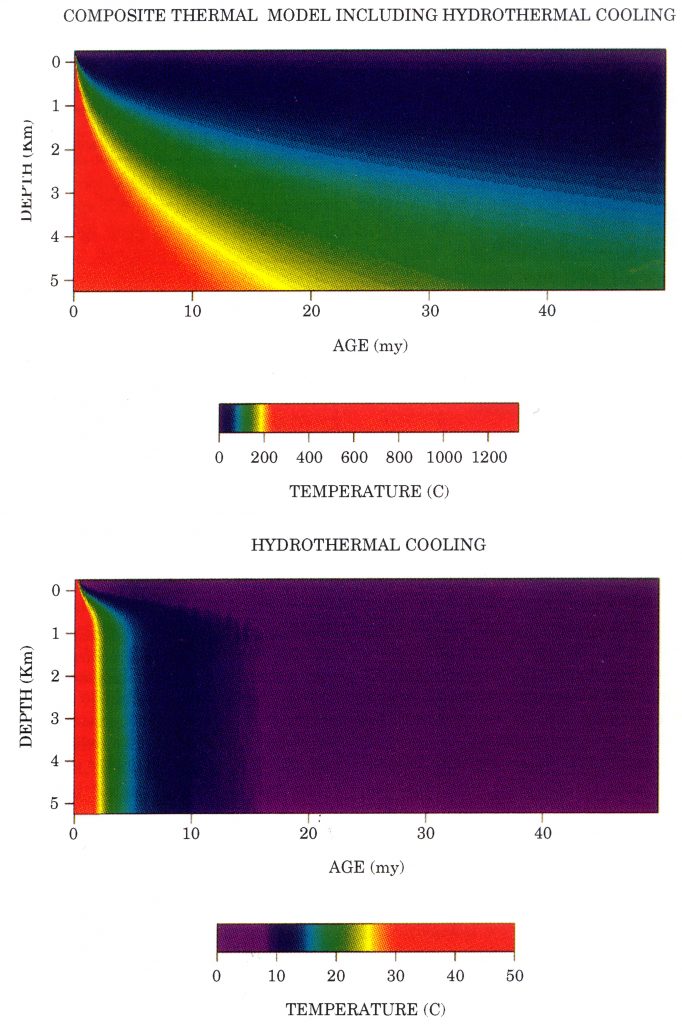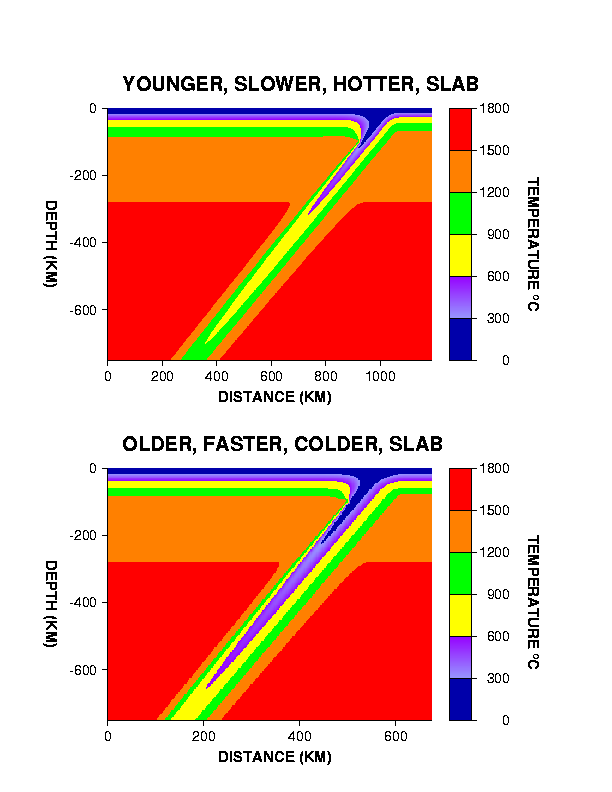Together with students and colleagues I have been involved with studying aspects of the thermal and mechanical evolution of oceanic lithosphere. One aspect, conducted primarily with students here, has been using seismological, marine magnetic, and seafloor topographic data to study the kinematics of plate boundary changes. We focused on areas where spreading centers split, with one ridge slowing spreading while the other speeds up, forming a rigid microplate. This approach, developed for oceanic spreading centers, was also extended to continental rifting in the Afar triple junction region of East Africa. The model describes the extension history, geometry and timing of rift formation, and paleomagnetic data indicating crustal rotations. It also has interesting implications for the evolution of rifted continental margins and paleo-oceanography. We have recently applied analogous ideas to the 2001 Bhuj earthquake in India, which has been interpreted as a continental intraplate earthquake. However, we favor a model in which it reflects motion at the boundary of a microplate breaking off the Indian plate as the India – Arabia – Eurasia triple junction evolves. This model has similarities to aspects of the evolution of the Sierra Nevada block.
Carol Stein (University of Illinois at Chicago) and I are analyzing the variations in seafloor depth and heat flow with age that provide the primary constraints on the thermal structure and evolution of the oceanic lithosphere. Moreover, regions of midplate volcanism and swells are identified by shallow seafloor depths. In turn, investigation of the processes giving rise to these regions rely on assessments of how the depths, heat flow, and flexural properties differ from those for unperturbed lithosphere. Such comparisons have been inhibited because reference thermal models assumed to describe unperturbed lithosphere predict deeper depths and lower heat flow than typically observed for lithosphere older than 70 Ma. As a result, depth and heat flow anomalies can be significantly overestimated. To address this difficulty, we derive a new model, GDH1, by joint fitting of heat flow and bathymetry, which implies that the lithosphere is hotter at depth and thinner than previously assumed. GDH1 fits the data, including that data from older (> 70 Ma) lithosphere previously treated as anomalous, significantly better than previous models. GDH1 thus facilitates analysis of processes including midplate volcanism and swells and differences in regional subsidence.
This approach is also useful for investigation of the magnitude and age distribution of the hydrothermal water flux through the oceanic lithosphere, one of the primary modes of interaction between the solid earth and the ocean/atmosphere system. An important result was that although heat flow in young lithosphere is highly variable, due to local hydrologic complexities, average heat flow decreases approximately linearly from near the axis to about 20 Myr and then is roughly constant to ~50 Myr. Hence heat flow can be combined with depths of midocean ridge earthquakes and magma chambers to constrain a simple thermal model for young lithosphere including the effects of hydrothermal circulation. We thus have a model against which survey data can be compared, and can be used to describe the global hydrothermal flux. We estimate that about 2/3 of the hydrothermal heat loss occurs by off-ridge and presumably low-temperature flow in crust older than 1 Myr, whose consequences for ocean chemistry differ significantly from those for high-temperature flow. Moreover, we can estimate the distance scale of water flow in young lithosphere and draw inferences about what controls the fraction of heat transferred hydrothermally.
The thermal model model reduces inferred anomalies at swells like Hawaii, implying little or no reheating of the lithosphere. (For details, click here). Hence it is important for the ongoing debate about whether hotspot swells are due to plumes rising from deep the the mantle, or are instead due to shallow process. This leads naturally to consideration of “Superswells”, such as the Darwin Rise region shown, where multiple hotspot tracks may indicate that in the Cretaceous (pre-70 Myr) an unusual outpouring of mantle heat produced a broad upwelling. Depth anomalies relative to different reference models yield quite different maps, and hence tectonic inferences. The entire Rise is shallow relative to a halfspace. Relative to PSM, much of the area is also shallow, suggesting a remnant regional thermal signature of the volcanism that formed the swells. However, because almost all lithosphere of this age is shallower than these models predict, the anomalies need not indicate that the Rise presently differs from lithosphere of this age elsewhere. In contrast, relative to GDH1, swells associated with volcanic chains are shallow, whereas depths between them are within a standard deviation of that predicted. Because of the three models GDH1 best describes average old lithosphere, it indicates that much of the Darwin Rise is not significantly deeper than lithosphere of the same age elsewhere, implying that the region between the swells retains no significant large-scale thermal signature of the Cretaceous events.
These studies have been extended, in joint research with recent graduates Phil Richardson and John Delaughter, using the earth’s geoid measured from satellite altimetry. The geoid is very valuable for these studies, because it gives a constraint on the geotherm complementary to those given by bathymetry and heat flow, and is in principle the best of these three data types for resolution of deep thermal structure.
A related effort is studying the thermal evolution of oceanic lithosphere after it starts subducting. E. Okal, S. Kirby from U.S.G.S., D. Rubie from Bayreuth (Germany) and I explored the possibility that deep-focus earthquakes result from phase changes in metastable minerals within the subducting lithosphere. Thermo-kinetic modeling shows that younger and slower subducting slabs (e.g., Aleutian) are hot enough that transformation of olivine to spinel keeps pace with the descent rate and is completed near the equilibrium phase boundaries. At most a small metastable region forms and deep earthquakes do not occur. Older and faster subducting slabs (e.g., Tonga) are colder and kinetic hindrance prevents transformation from keeping pace with the descent rate. These predictions are consistent with the variation in earthquake depths between and along subduction zones, and have interesting consequences for the subduction process. Work with former grad student Fred Marton, and C. Bina has found that the negative feedback via the positive compositional buoyancy from metastability may be important in regulating subduction rates.
References:
Stein, C. and S. Stein, A model for the global variation in oceanic depth and heat flow with lithospheric age, Nature, 359, 123-128, 1992.
Shoberg, T., C. Stein, and S. Stein, Constraints on lithospheric thermal structure for the Indian Ocean basin from depth and heat flow data, Geophys. Res. Lett., 20, 1095-1098, 1993.
Stein, C. and S. Stein, Constraints on Pacific midplate swells from global depth-age and heat flow-age models, in Pringle, M., W. Sager, W. Sliter, and S. Stein (eds), The Mesozoic Pacific, Geophysical Monograph 76, 53-76, American Geophysical Union, 1993.
Helffrich, G. and S. Stein, Study of the structure of the slab/mantle interface using reflected and converted seismic waves, Geophys. J. Int., 115, 14-40, 1993.
Stein, C. and S. Stein, Constraints on hydrothermal flux through the oceanic lithosphere from global heat flow, J. Geophys. Res, 99, 3081-3095, 1994.
Pelayo, A., S. Stein, and C. Stein, Estimation of oceanic hydrothermal heat flux from the depths of midocean ridge seismicity and magma chambers and heat flow data, Geophys. Res. Lett., 21, 713-716, 1994.
Stein, C. and S. Stein, Comparison of plate and asthenospheric flow models for the evolution of oceanic lithosphere, Geophys. Res. Lett., 21, 709-712, 1994.
Stein, C. and S. Stein, Modeling heat flow and hydrothermal circulation in young crust, Ridge Events, 6, 1, 9-11, 1995.
Stein, C., S. Stein, and A. Pelayo, Heat flow and hydrothermal circulation, in: Physical, chemical, biological and geological interactions within hydrothermal systems, AGU Mono., edited by Humphris, S., L. Mullineaux, R. Zierenberg and R. Thomson, Am. Geophys. Un., Washington, D.C., 425-445, 1995.
Richardson, P., S. Stein, C. Stein, and M. Zuber, Geoid data and the thermal structure of oceanic lithosphere, Geophys. Res. Lett., 22, 1913-1916, 1995.
Stein, S., Deep earthquakes: a fault too big?, Science, 268, 49-50, 1995.
Kirby, S., S. Stein, D. Rubie, and E. Okal, Deep earthquakes and metastable phase changes in subducting oceanic lithosphere, Rev. Geophys., 34, 261-306, 1996.
Stein, S., and C. Stein, Thermo-mechanical evolution of oceanic lithosphere: implications for the subduction process and deep earthquakes, in: Subduction: Top to Bottom, Geophysical Monograph 96 edited by G. Bebout, D. School, and S. Kirby, Am. Geophys. Un., Washington, D.C., 1-17, 1996.
Stein, S., and C. Stein, Ocean depths and the Lake Wobegone Effect, Science, 275, 1613-1614, 1997.
Stein, C., and S. Stein, Estimation of lateral hydrothermal flow distance from spatial variations in oceanic heat flow, Geophys. Res. Lett., 24, 2323-2326, 1997.
Marton, F., C. Bina, S. Stein, and D. Rubie, Effects of slab mineralogy on subduction rates, Geophys. Res. Lett., 26, 119-122, 1999.
DeLaughter, J., S. Stein, and C. Stein, Extraction of the lithospheric aging signal from satellite geoid data, Earth. Planet Sci. Lett., 174, 173-181, 1999.
Stein, S. and D. Rubie, Deep earthquakes in real slabs, Science, 286 909-910, 1999.
Bina, C., S. Stein, F. Marton, and E. VanArk, Implications of slab mineralogy for subduction dynamics, Phys. Earth Planet. Int., 127, 51-66, 2001.
Stein, C. and S. Stein, Mantle plumes: heat flow near Iceland Astronomy and Geophysics, 44, 8-10, 2003.



